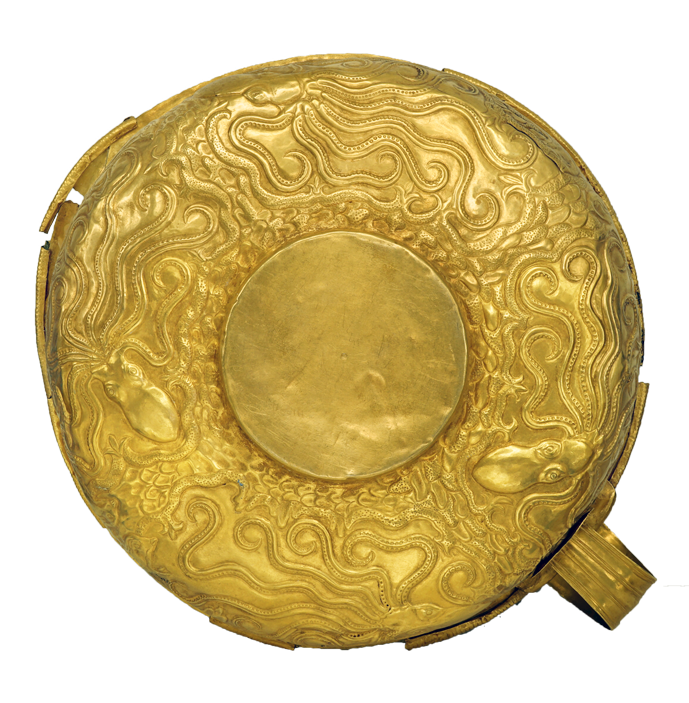Exhibit of the month
πλέων επί οίνοπα πόντον… (sailing over the wine-dark sea …) Odyssey Book I, 183
Gold cup decorated with seascape
National Archaeological Museum
Collection of Prehistoric, Egyptian, Cypriot and Near Eastern Antiquities, inv. no. Π 7341
Provenance: Tholos tomb at Dendra near Midea, pit I.
Dimensions: Height: 5 cm, Diam. 17.3 cm.
Date: 15th c. BC.
Display Location: Prehistoric Collection, Mycenaean Gallery 4, Showcase 36.
On Monday August 2, 1926, the Swedish excavators of the tholos tomb at Dendra in Argolis, brought to light a rich royal burial of the early Mycenaean world. The valuable grave goods included a masterful shallow cup made of gold that had been deposited on the chest of the deceased and contained four gold and silver rings as well as six sealstones.
The cup is made of a large gold sheet decorated in repoussé. The composition covers the main surface of the vessel up to the open neck. The cup was possibly made by two craftsmen. Apparently, the first craftsman designed the main figures of the composition, but managed to complete only the first of the four octopuses to the right of the handle. The rendering of the figure, its details and the surrounding supplementary motifs is shallower, more accurate and elaborate compared to the others. The completion of the remaining figures and motifs and also the lower finishing of the handle, which is almost flat, have been attributed to the second craftsman. The work of the first artist is marked by greater plasticity, movement and realism and therefore he is regarded an exquisite craftsman, active in Minoan workshops that had a long tradition in producing such works of minor arts. On the other hand, the work of the second artist is less skilful and more hastily executed.
The creators of the vessel hammered on its inner surface a vivid seafloor scene with octopuses, argonauts, dolphins, rocks and corals arranged harmoniously over the entire field. The theme of the submarine landscape and its creatures gained exceptional popularity in the visual arts of neopalatial Crete, the Cyclades, and the early Mycenaean world from the 17th to the 15th c. BC. Surfaces of ceramic and stone vases, wall paintings, sealstones, even weapon blades were transformed into aquatic worlds of small nautiluses and perky dolphins. The decoration of the Dendra cup with this theme is integrated in the prevailing aesthetic preference of the time. However, the execution of the decorative field of this vessel entails a bizarre element.
The user of the gold cup would see the patterns hammered from the inner surface of the article. In order to be able to clearly see them raised in relief he would have to lift the vessel and turn it upside down so as to enjoy its invisible side. Therefore, one wonders why this painstaking work had been executed on such an awkward surface. The excavator, Axel Persson, reports a rare and picturesque account of an incident that took place during the excavation of the site and perhaps has the answer to the puzzle. It involves the visit of an elderly man from Mycenae “Mr. Dimitris” who had worked 37 years ago together with Christos Tsountas in the tholos tomb of Vapheio. The old man visited the excavated site of Dendra, admired the superb finds and was offered Nemea wine by Persson, served in the original gold cup. As he swirled the semi-transparent liquid, the repousse figures on the inner surface of the vessel were enlivened, most likely due to the refraction of light at the bottom of the cup, and, as a result of their depressions, the octopuses looked as though they stirred and moved indolently.
Dr K. Paschalidis
Bibliography
Davis E.N., The Vapheio Cups and Aegean Gold and Silver Ware, New York and London 1977, 276-280, figs 224-227.
Persson A.W., The Royal Tombs at Dendra near Midea, Lund 1931, 16, 31-32, pl. 9-11, 18.


